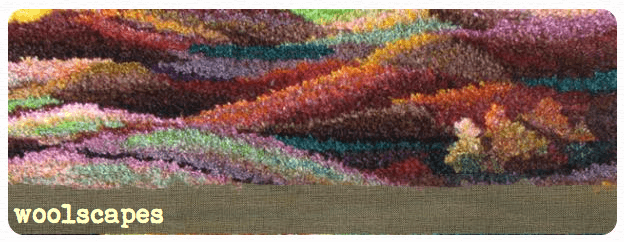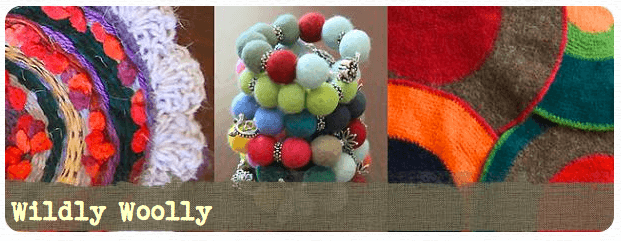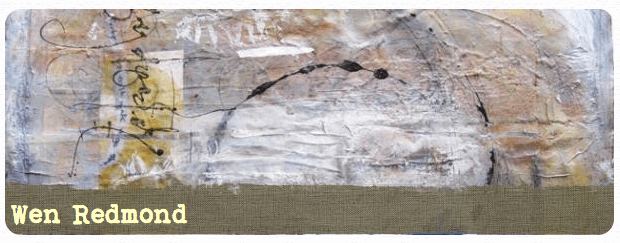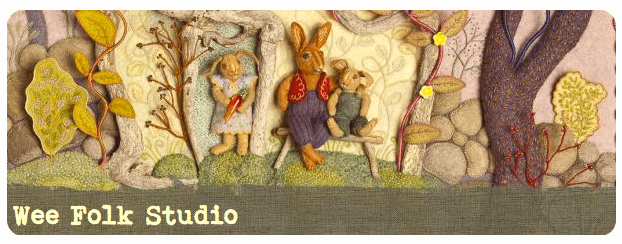Posts Tagged ‘Wildly Woolly’
Even More from The Textile and Fiber Art List!
Oh, for an endless amount of money to spend on art! TAFA is like my own private store, and I WANT WANT WANT everything I see. Enjoy these new artists this week.
 From Hana: “Weaving technology is the use of woolen thread on mesh canvas with the aid of a hook. The weaving in itself is accomplished in free flow on a direct path from the “picture in one’s mind” to the canvas, without a previously drawn sketch on paper or canvas. This type of work enables maximum spontaneity and allows for a free flow of mood and color within the framework of the subject on the one hand (desert landscape for example) but on the other hand, enables the carpet to evolve and “breathe” in the process of its creation. In addition to weaving wall carpets I also paint, mostly oil on canvas but I use other techniques as well. My paintings are strictly figurative and very different from my carpets. While the carpets essentially try to convey the mood of a landscape through the free and more abstract use of form and color the paintings are either portraits or still life scenes that emphasize the composition of the scene or the mood of the person in the portrait. The colors I use in the paintings are not as bright as those I use in the carpets and they have a more introvert and subdued nature.” Woolscapes
From Hana: “Weaving technology is the use of woolen thread on mesh canvas with the aid of a hook. The weaving in itself is accomplished in free flow on a direct path from the “picture in one’s mind” to the canvas, without a previously drawn sketch on paper or canvas. This type of work enables maximum spontaneity and allows for a free flow of mood and color within the framework of the subject on the one hand (desert landscape for example) but on the other hand, enables the carpet to evolve and “breathe” in the process of its creation. In addition to weaving wall carpets I also paint, mostly oil on canvas but I use other techniques as well. My paintings are strictly figurative and very different from my carpets. While the carpets essentially try to convey the mood of a landscape through the free and more abstract use of form and color the paintings are either portraits or still life scenes that emphasize the composition of the scene or the mood of the person in the portrait. The colors I use in the paintings are not as bright as those I use in the carpets and they have a more introvert and subdued nature.” Woolscapes
 From Wil Opio Oguta :”Inspiration for the quilts I make comes from a variety of sources. It can be nature, an expression, a color or a material. For most of my quilts I use my own hand dyed fabric. My quilts can be very colorful or simply black and white. I work in a contemporary style, but have no objection at all to incorporating traditional blocks. Often I use raw edge appliqué, but don’t be surprised if I switch techniques for another quilt. I love working with fiber, but if the quilt wants/needs it, I add other materials to it. This can be bark, buttons, lutrador and paint. It all depends on what I feel is needed. For me, making art quilts is a way of expressing what I see, translating the world into fabric and fibers, emphasizing/focusing on what is important to me and to show you how I feel about it.” WilOpioOguta
From Wil Opio Oguta :”Inspiration for the quilts I make comes from a variety of sources. It can be nature, an expression, a color or a material. For most of my quilts I use my own hand dyed fabric. My quilts can be very colorful or simply black and white. I work in a contemporary style, but have no objection at all to incorporating traditional blocks. Often I use raw edge appliqué, but don’t be surprised if I switch techniques for another quilt. I love working with fiber, but if the quilt wants/needs it, I add other materials to it. This can be bark, buttons, lutrador and paint. It all depends on what I feel is needed. For me, making art quilts is a way of expressing what I see, translating the world into fabric and fibers, emphasizing/focusing on what is important to me and to show you how I feel about it.” WilOpioOguta
 From Kim Buchheit: “Kim is a designer and artist living and working in Grand Canyon National Park. Her love of felt is rooted in an affection for its understated beauty, a fondness for the old-world craft of felt-making, and the simple earth-and animal-friendly nature of the materials used in the process.” Wildly Woolly
From Kim Buchheit: “Kim is a designer and artist living and working in Grand Canyon National Park. Her love of felt is rooted in an affection for its understated beauty, a fondness for the old-world craft of felt-making, and the simple earth-and animal-friendly nature of the materials used in the process.” Wildly Woolly
 From Wen Redmond: “I am quite passionate about my work. I continue to explore my chosen medium, fabric, to see what it can do, to stretch its perception as art medium. When I work, I encourage a collaborative process with spirit or my higher self, that mind-boggling principle of the universe. This process can also be called ‘flow’. When you are in this state of mind, the intuitive is tapped and the work can become more than the sum of it’s parts. I work out insights, inspirations, feelings and reactions to the outer world. Allowing time for these inspirations to percolate up from my unconscious is a vital part of my process. Each piece is wrought individually and is one of a kind. These include original photographs, artistically manipulated, printed on prepared fabrics and various textile substrates. The works can include painting, dying, stamping screen-printing, mono printing and other means of surface design. Among a variety of presentations, I created an innovative technique, Holographic Images, employing photographs on silk organza to create a unique 3-D effect. Layers peeled back reveal the source, the inspiration, and my mad desire to capture thoughts, dreams and the beauty of nature. ” Wen Redmond
From Wen Redmond: “I am quite passionate about my work. I continue to explore my chosen medium, fabric, to see what it can do, to stretch its perception as art medium. When I work, I encourage a collaborative process with spirit or my higher self, that mind-boggling principle of the universe. This process can also be called ‘flow’. When you are in this state of mind, the intuitive is tapped and the work can become more than the sum of it’s parts. I work out insights, inspirations, feelings and reactions to the outer world. Allowing time for these inspirations to percolate up from my unconscious is a vital part of my process. Each piece is wrought individually and is one of a kind. These include original photographs, artistically manipulated, printed on prepared fabrics and various textile substrates. The works can include painting, dying, stamping screen-printing, mono printing and other means of surface design. Among a variety of presentations, I created an innovative technique, Holographic Images, employing photographs on silk organza to create a unique 3-D effect. Layers peeled back reveal the source, the inspiration, and my mad desire to capture thoughts, dreams and the beauty of nature. ” Wen Redmond
 From Salley Mavor: ” have had a life-long fascination with little things and needlework. Toward the end of art school, I rediscovered my childhood delight in sewing and creating miniature scenes. Leaving traditional illustration mediums behind, but still interested in narrative work, I taught myself stitching and fiber art techniques. For me, manipulating materials with my hands with a needle and thread was so much more satisfying than rendering with a pencil or brush. I found that I could communicate my ideas more clearly this way and that my hands would direct me in a compelling way. My early pieces were soft sculpture, and then turned flatter, with raised figures and objects on a fabric background. I came up with the term “fabric relief” in 1982 to better describe my evolving technique. My 3-dimentional pictures resemble miniature, shallow stage sets, with scenery, props and characters telling a story. I embroider, wrap, appliqué and paint different materials and found objects to create scenes in relief, with figures imposed on an embellished fabric background. My work is decorative and detailed, full of patterns from nature, all stitched by hand. For the past 20 years, I’ve been working in the field of illustration, making artwork which is then photographed and printed in children’s books. The original fabric relief pictures have a second life when they are mounted and framed under glass in shadow boxes, ready to display as individual pieces. ” Wee Folk Studio
From Salley Mavor: ” have had a life-long fascination with little things and needlework. Toward the end of art school, I rediscovered my childhood delight in sewing and creating miniature scenes. Leaving traditional illustration mediums behind, but still interested in narrative work, I taught myself stitching and fiber art techniques. For me, manipulating materials with my hands with a needle and thread was so much more satisfying than rendering with a pencil or brush. I found that I could communicate my ideas more clearly this way and that my hands would direct me in a compelling way. My early pieces were soft sculpture, and then turned flatter, with raised figures and objects on a fabric background. I came up with the term “fabric relief” in 1982 to better describe my evolving technique. My 3-dimentional pictures resemble miniature, shallow stage sets, with scenery, props and characters telling a story. I embroider, wrap, appliqué and paint different materials and found objects to create scenes in relief, with figures imposed on an embellished fabric background. My work is decorative and detailed, full of patterns from nature, all stitched by hand. For the past 20 years, I’ve been working in the field of illustration, making artwork which is then photographed and printed in children’s books. The original fabric relief pictures have a second life when they are mounted and framed under glass in shadow boxes, ready to display as individual pieces. ” Wee Folk Studio
